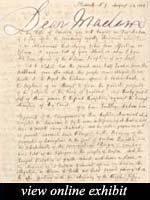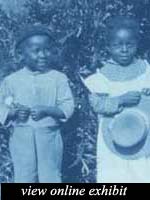|
Digital
History>Virtual Exhibitions
Virtual Exhibitions
 |
A House Divided: America in
the Age of Lincoln
|
| |
|
 |
America's Reconstruction: People
and Politics After the Civil War
This
exhibit examines one of the most turbulent and controversial
eras in American history. It presents an up-to-date
portrait of a period whose unrealized goals of economic
and racial justice still confront our society. |
| |
|

|
Dear
Madam: Letters Between Catharine Macaulay and Mercy
Warren
These eighteenth century
letters are evidence of an extraordinary correspondence.
Here the great historian of England and one of the first
historians of the United States exchange their thoughts
and ideas. And both individuals just happen to be women.
|
| |
|

|
Photograph
Album with Cyanotypes. Richard Riley,
[ca. 1896-1903].
Founded in 1892, the
Calhoun Industrial School in Alabama was a freedmen's
school devoted to industrial education. Calhoun was
also a social settlement in which blacks and whites
lived and worked side by side. The teachers, both black
and white, assisted members of the community, especially
recently freed African Americans, in gaining self-sufficiency.
They believed that education would improve ex-slaves'
living conditions. Through the school, they acted upon
the words, "Education will prove the equality of
the races." |
| |
|

|
Frederick
Douglass' Letter to Mary Todd Lincoln [1865]
Autograph letter signed,
dated Rochester, New York, 17 August 1865, to Mary Todd
Lincoln.
In this letter, Douglass
thanks recently widowed Mary Todd Lincoln for her gift
of Abraham Lincoln's walking cane.
"I assure you,
that this inestimable memento of his presidency will
be retained in my possession while I live.."
|
| |
|
 |
Water
Color Sketchbook by Private Henry Berckhoff
8th New York
"German Rifles"
27 May 1861 to 23 May 1863
What did the Civil War
look like to the soldiers who fought in it? The pictures
in this exhibition were drawn by a young Union soldier,
Henry Berckhoff, during the war. Berckhoff sketched
these pictures in graphite and later added ink and watercolor.
He also attached the images to paper boards and bound
them together. |
|
